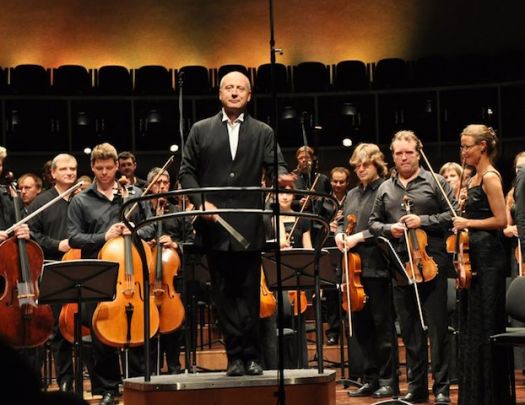
Pärnu Festival Juxtaposes Beethoven and Strauss
Paavo Järvi led the Pärnu Festival Orchestra in a handsome
program with thematic connections July 17 in the sparkling glass-walled Concert
Hall in Pärnu, Estonia.

It was the fourth concert of the Pärnu Music Festival, underway since July 16 in this sparkling resort city on the shores of the Baltic Sea.
Juxtaposed was music by Beethoven and Richard Strauss, specifically Beethoven’s Symphony No. 3 (“Eroica”) and Strauss’ “Metamorphosen.” Composed in 1945, the latter is a reflection on the glory of German music viewed through the devastation of World War II and a grievous lament over humankind’s descent into bestiality (a kind of metamorphosis backwards).
Germany’s opera houses and concert halls lay in ruins as Strauss wrote ”Metamorphosen.” Scored for 23 solo strings, it was performed with deep feeling by members of the Festival Orchestra, beginning with a poignant incantation by the four cellos. Threaded through its dense counterpoint is a solemn theme derived from the Funeral March of Beethoven’s “Eroica,” giving it a truly searing effect. Just before the end an actual quotation of the “Eroica” theme appears in the double bass (inscribed “in memoriam” by the composer) as if to seal the work’s evocation of the Bonn master.
Järvi kept his hands in the air for a long moment as the music faded, then slowly dropped them to signal the applause. It was a long time coming, so transported were the listeners in the hall.
A light exploded above the stage during the opening bars of the “Eroica,” giving off a sound like a shot and causing Järvi to put his hand to his chest (in jest). (Beethoven announcing his presence, the musicians joked afterwards.) The music continued uninterrupted, however, brisk, percussive and con brio in every respect. The second movement Funeral March was highly effective, in part because of the dry, military sound achieved by the timpanist. The clarinet pealed above the ensemble at one point and extremes of dynamics were favored, yielding a heart-rending impression.
Ensemble was a bit wobbly at the very beginning of the Scherzo, but things soon took hold and the horns had a crowning moment in the Trio section. Järvi moved with scarcely a pause into the Finale. The variations were full of character here, even boisterous at times, and Järvi crafted gestures to match (sawing motions to emulate the strings, for example). The conclusion – blazing hot and quick as a wink – drew the crowd to its feet amid a chorus of cheers. Encore was a repeat of the Scherzo.
The concert opened with more Beethoven, his Overture to “The Creatures of Prometheus” (another "Eroica" connection,” as the variations theme first appears in the finale of the ballet). The performance was crisp and full of vigor, with fine string ensemble and melodious winds, a fitting prelude to what was, in fact, a celebratory concert.